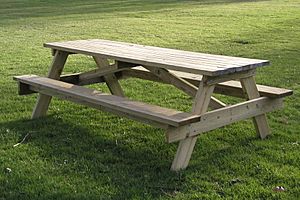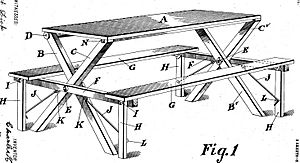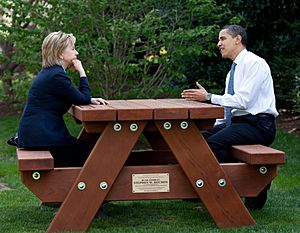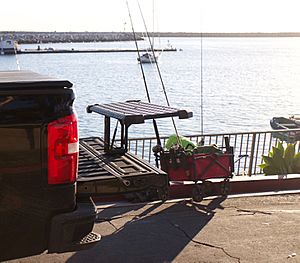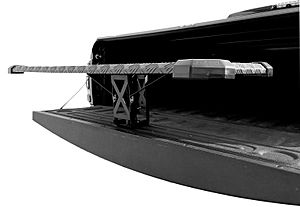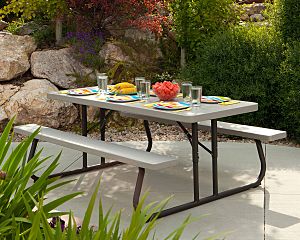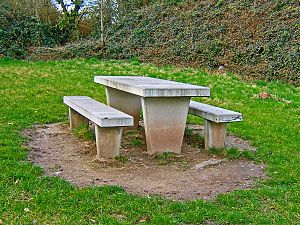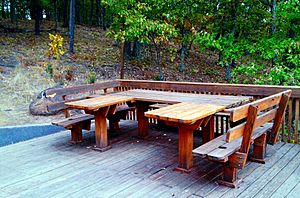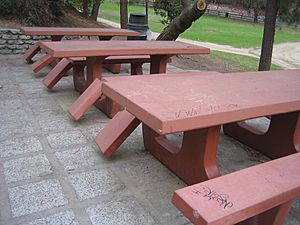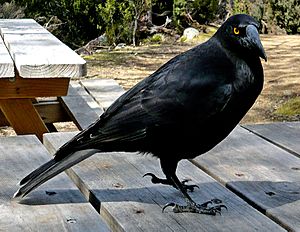Picnic table facts for kids
A picnic table is a special table with benches, usually attached, made for eating outdoors. You often see them at parks, campgrounds, or even in backyards. Most picnic tables are rectangular and have a strong A-frame design. Even if they are used inside, they are still called picnic tables!
People have used different kinds of tables for outdoor meals throughout history. But the classic A-frame picnic table, which we know today, first appeared in the United States in the early 1900s. The very first similar table was described in 1903. A popular modern design, called a "Lassen table," was first used in 1926.
Picnic tables are usually made from wood. However, they can also be made from other materials like concrete or recycled plastic. They come in many shapes, such as circles or hexagons, and in different sizes. Some designs are even made to be easy for people in wheelchairs to use.
Picnic tables are popular in parks and other public places because they are simple and informal. People use them for eating, learning, playing games, and spending time together. Their popularity can affect the plants, animals, and soil around them. This is because animals often come looking for human food. Sadly, picnic tables can also be targets for vandalism.
Contents
History of Picnic Tables
Picnics became popular during the Victorian era. People would often just spread a blanket on the ground. Sometimes, they would even bring their indoor dining furniture outside! But this was hard because indoor furniture was heavy and not made for outdoor use.
The first modern picnic table was described in 1903. It was part of a patent application by Charles H. Nielsen from New York. Nielsen's table was special because it could be carried and folded up. This meant picnickers could take it anywhere they wanted. His design used legs similar to an old 18th-century "sawbuck table," but the built-in seats were a new idea.
In the early 1900s, US national parks and forests started using fixed picnic tables more often. These tables helped control where people gathered, protecting the natural areas around them. So, the tables were designed to be very heavy and hard to move.
Many different picnic table designs were tried at first. One popular design in the 1920s had a sawbuck table with separate benches. But these benches often disappeared from public parks! Other designs didn't work well because they weren't strong enough or were too hard to build.
The classic A-frame picnic table solved these problems. It was first created at Lassen National Forest in California in 1926. That's why it was known as a "Lassen table" by the US Forest Service. These famous Lassen tables became common across the United States thanks to the Civilian Conservation Corps (CCC) in the 1930s.
The first known picnic table placed by a road was set up in 1929 in Michigan. It was made from old highway guardrail planks.
How Picnic Tables Are Used
Picnic tables are used for many activities, like eating, resting, doing crafts, and more. You can find them outdoors in many public parks, people's backyards, rest areas, campgrounds, and amusement parks. Picnic tables are also used indoors when people want tables with attached seating.
Picnic Tables in Cities
In cities, picnic tables are often used as street furniture. They create a friendly space where neighbors can easily talk to each other. In areas without much space, people sometimes put picnic tables in their front yards for this same reason. Picnic tables are also great for outdoor dining at food trucks or small restaurants that don't have indoor seating.
Outdoor Learning and Meetings
Picnic tables are very useful for outdoor learning. They provide a good place to sit and a flat surface to work on. They have even played a role in outdoor education history! In 1983, women educators met around a picnic table at midnight to discuss challenges they faced in their field. This meeting led to more conversations and attention to these issues.
Because they are informal and outdoors, picnic tables have also been used for serious meetings. For example, Israel and Jordan, who were officially at war, held secret talks about water issues at a picnic table near the Yarmuk and Jordan rivers.
In 2009, a playset with a wooden A-frame picnic table was put on the White House lawn for the president's daughters. It even had the names of 44 US presidents carved into it! Later, it was thought that a famous meeting between President Obama, Henry Louis Gates, and a police officer would happen at this picnic table. However, that meeting actually took place at a different table in the Rose Garden. In 2017, the playset was given to a local charity.
Picnic tables are often used for outdoor activities at campsites, scenic spots, or common areas. Some special picnic tables can even attach to the back of a pickup truck. These are great for camping, fishing, hunting, sports events, barbecues, or even as an outdoor computer desk!
Picnic Table Design
Shapes of Picnic Tables
The most common picnic table shape is rectangular, with a straight bench on each long side. In the United States, this rectangular shape is so well-known that it's used as the symbol for picnic areas on road signs. However, picnic tables come in many other shapes, like circular, hexagonal, and octagonal designs. Circular and octagonal tables became popular in California in the early 1900s because they were better for playing card games.
Where Picnic Tables Are Found
Most picnic tables are fixed or foldable structures. They can be free-standing or attached to the ground. You usually find them at landmarks, scenic views, or public places, where people can rest and gather.
A mobile picnic table is different because it doesn't stay in one spot. It can be moved around with its platform and used for many different things. Some mobile picnic tables can even be attached to the tailgate of pickup trucks.
Sizes of Picnic Tables
A typical picnic table can seat six to eight people. But you can also find smaller or larger tables. Smaller picnic tables are often made just for children. Rectangular picnic tables in parks are usually about 6 to 8 feet (1.8 to 2.4 meters) long.
Materials Used for Picnic Tables
The materials used for picnic tables have changed over time. In 1969, a study found that 95% of picnic tables had some wood, and 81% were made completely of wood. Today, more and more tables are made from plastic, concrete, or metal. Sometimes, they even use a mix of fiberglass and metal.
Wooden Picnic Tables
Wooden tables are usually built using lumber boards. The wood needs protection, like stain or paint, to stop it from cracking, warping, or rotting from moisture. The tabletop and benches are attached to the frame with screws or nails. The legs are often held together with strong bolts, nuts, and washers.
For public parks, there were different ideas about using local wood versus wood bought from stores. Sometimes, rough local wood was used for the supports, and smoother store-bought boards were used for the benches and tabletop. In California in the 1930s, parts of redwood and fir trees were sometimes used, but they didn't last long enough.
Stone or Concrete Picnic Tables
Picnic tables made of stone or concrete are very strong and last a long time, but they can be expensive. They are also very hard or impossible to move. This can be a good thing if you want them to stay put, or a bad thing if you need to move them. These tables became common in the United States in the 1930s, often as part of Civilian Conservation Corps projects. However, stone tables were not ideal because they couldn't be moved even if the whole picnic area needed to be changed.
Plastic Picnic Tables
Plastic picnic tables are becoming more popular. They are lighter, last longer, and cost less than wooden tables. They also need less care. A common material for plastic "lumber" in picnic tables is recycled HDPE plastic. This plastic can be mixed with other materials like wood fibers to make it even stronger.
Metal Picnic Tables
Metal picnic tables are also gaining popularity in public parks. They are heavy and durable, and they don't need much maintenance. Sometimes, metal tables are bolted onto concrete pads to prevent theft. Steel coated with thermoplastic is often used to make them even tougher for outdoor use. Also, strong metal picnic tables are sometimes used indoors in places like prisons.
Making Picnic Tables Accessible
Picnic tables can sometimes be tricky for people with disabilities, especially those who use wheelchairs.
In the United States, federal parks and recreation areas must have picnic tables that are easy for disabled users to access. At least 20% of the picnic tables should be accessible. If there are only one or two tables, they all must be accessible. For businesses like restaurants, at least 5% (and no less than one) of their tables, including picnic tables, must be accessible under the Americans with Disabilities Act (ADA).
Even "accessible" picnic tables can sometimes be difficult to use. A common problem is soft or uneven ground around the table, which makes it hard for wheelchairs to move. To fix this, some US states, like New York, require picnic tables to be placed on a concrete pad.
Picnic Tables with Other Features
Picnic tables are often built alongside other park features, like shelters and barbecue grills. These might all be on the same concrete pad. Sometimes, a bottle opener is attached to the table's edge. This helps stop people from damaging the tabletop when opening bottles. Early US Forest Service picnic tables sometimes had shelves and cupboards, but these were hard to keep clean and were stopped after 1941.
Newer technologies have also been added to picnic tables. Sonoma State University created a "Smart Table" that has a solar charging station, a sun shade, and a weather station all built into a picnic table.
Problems with Picnic Tables
Writing or carving on picnic tables is a common type of vandalism in parks. Studies have shown that vandalism is more likely to happen when a picnic table has already been vandalized. This is because existing damage can encourage new vandals. So, park managers can help prevent vandalism by fixing any damage quickly. While writing is the most common type of vandalism, wooden picnic tables are sometimes broken up by campers to be used as firewood.
Because flat wooden surfaces can rot in wet places, picnic tables used to be treated with chemicals to protect the wood. These chemicals helped the wood last longer. However, these treatments could be harmful. In the United States, a chemical called chromated copper arsenate (CCA) was widely used for outdoor wood until 2003. This chemical could slowly release small amounts of arsenic over time. Now, safer treatments are used to protect wooden picnic tables.
Environmental Impacts of Picnic Tables
Picnic tables are important for how much people enjoy a park and whether they want to visit it. This can have both good and bad effects on the environment. The ground right around a picnic table often gets very worn down from people walking on it. This damage is usually only in a small area. But in rainy places, this worn ground can lead to soil washing away.
During picnic season, picnic tables often attract animals looking for human food. For example, tiny ticks have been found on picnic tables as often as in leaf litter. Hornets and other wasps might also build nests under picnic table platforms or benches. These spots are sheltered and close to a food source.
Picnic tables provide a source of food for some animals. Birds like crows and jays often look for food near picnic tables. Male Steller's Jays, in particular, like to claim areas near picnic tables because of the good feeding opportunities.
Other Ways to Dine Outdoors
Picnic tables are not the only special tables used for eating outdoors. For example, in Korea, people traditionally sit on the floor to eat. So, outdoor meals are often held on low wooden platforms called pyeongsang. People sit directly on these platforms instead of next to them. These pyeongsang are sometimes called "portable wooden decks." Like picnic tables, they can help people gather and interact when used in public spaces. Also, in both Korea and Japan, people sometimes use picnic mats or sheets to create a comfortable, portable dining area.
See also
 In Spanish: Merendero para niños
In Spanish: Merendero para niños


